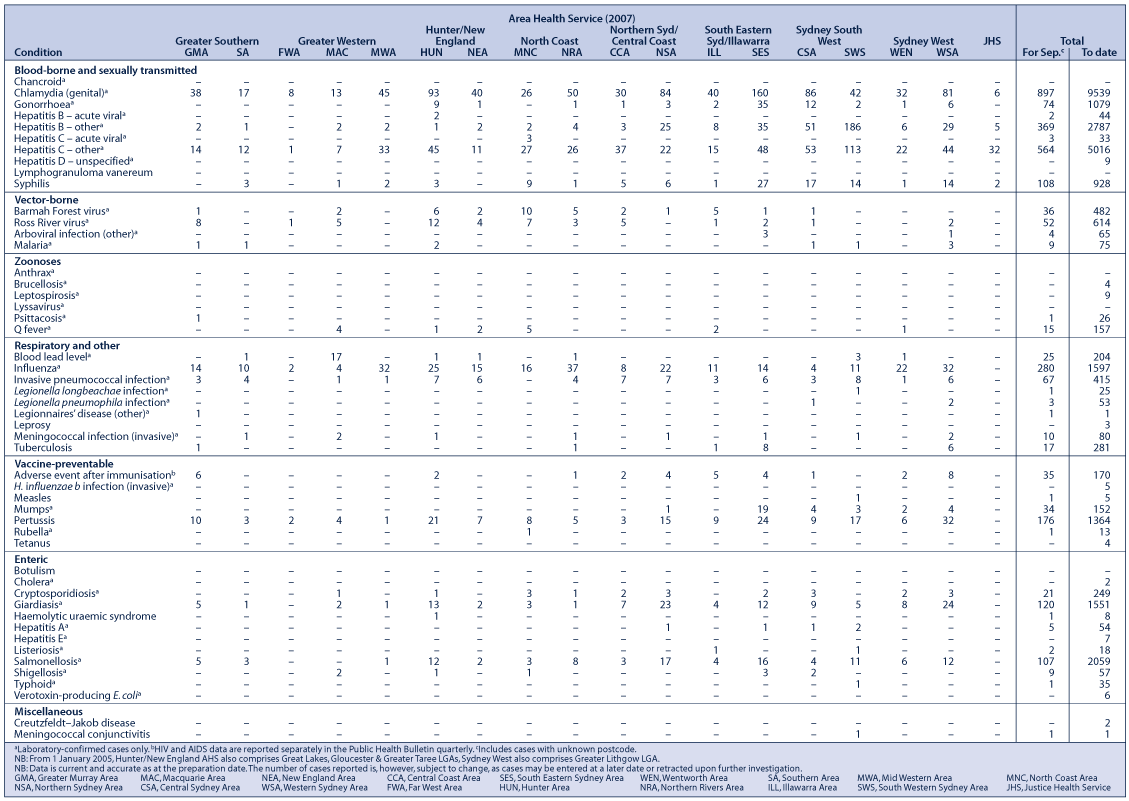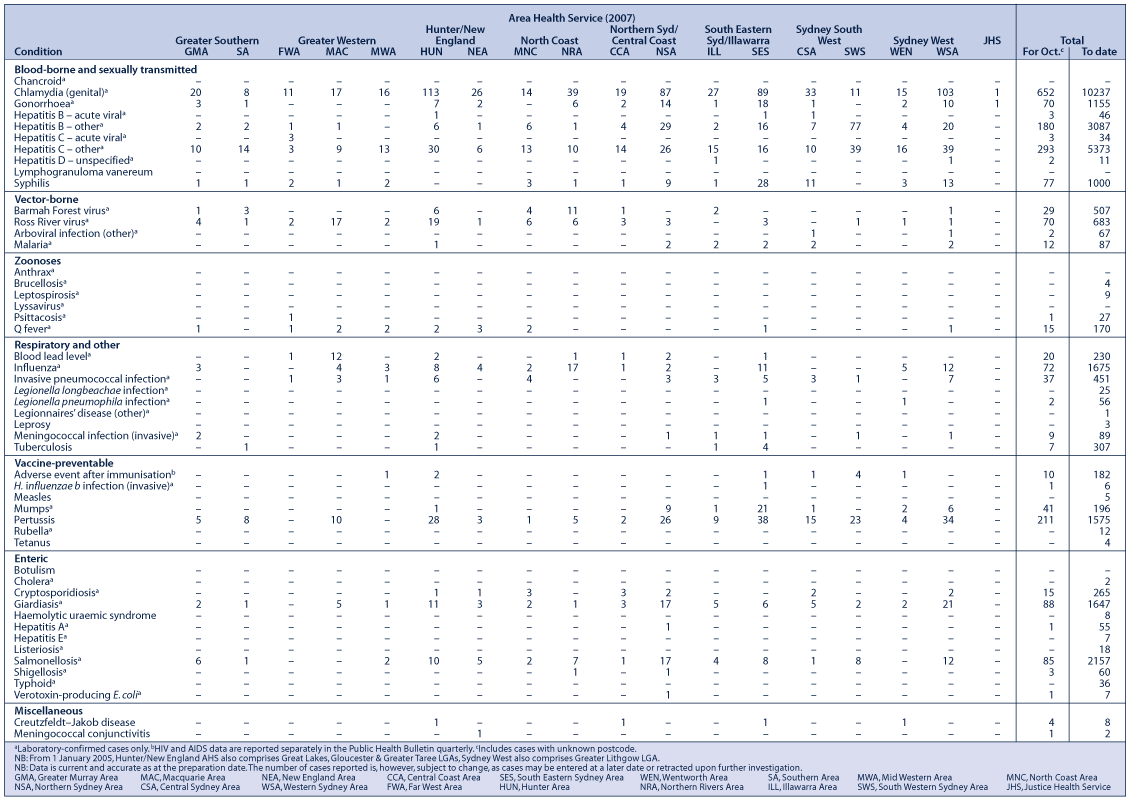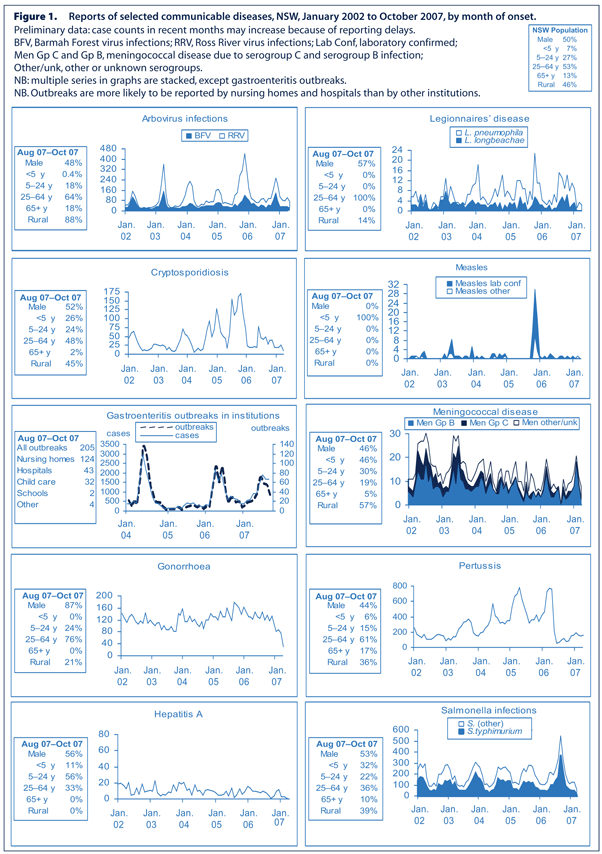Communicable Diseases Report, New South Wales, September and October 2007
Communicable Diseases Branch, NSW Department of Health
NSW Public Health Bulletin 18(12) 246-250 https://doi.org/10.1071/NB07117
Published: 6 December 2007
Abstract
Abstract:
For updated information, including data and facts on specific diseases, visit www.health.nsw.gov.au and click on Infectious Diseases.
Tables 1 and 2 and Figure 1 show reports of communicable diseases received through to the end of September and October 2007 in NSW.

|

|

|
Influenza
Influenza activity – measured by the number and rate of people presenting with influenza-like illness to selected emergency departments, and by the number and rate of people testing positive for influenza at selected laboratories – returned to baseline levels in September. Overall, NSW experienced a moderately severe influenza season, with presentations to emergency departments peaking in mid-August (9/1000 presentations), a rate not seen since 2003. Most cases of influenza were due to influenza A virus. For more information see http://www.health.nsw.gov.au/infect/pdf/flureport.pdf.
Meningococcal disease
In September, 10 people were notified in NSW with meningococcal disease and one of these died. A further 11 cases were notified in October. In total, 91 cases have been notified in NSW in 2007, including three deaths. Of the 2007 cases, nine were due to serogroup C meningococcal bacteria (which is covered by the vaccine recommended for one to 23 year olds) and 56 were due to serogroup B (which is not covered by the vaccine). For the first 10 months of 2006, 91 cases were notified including six deaths. For more information see http://www.health.nsw.gov.au/infect/pdf/mening_update.pdf.
Mumps
The number of notifications of mumps has steadily increased in the last few months. In 2003, 35 cases were reported in NSW. This number has steadily increased each year from 28 in 2001 to 153 in 2006. Through to September 2007, 148 cases were reported for 2007. Only laboratory reports of mumps are counted in NSW, so this figure likely underestimates the true cases of mumps circulating in the community. Among the 168 cases reported in the 12 months to September, 116 (69%) were aged 15–34 years, and in this age group 67% were males, compared with only 54% in other age groups. Compared with older people, people aged 15–34 years are less likely to have been infected with the mumps virus as children, and compared with younger age groups, are less likely to have received mumps-containing vaccine (first introduced in 1980) as part of their routine childhood immunisation. In NSW, year 7 girls were vaccinated through a school-based immunisation program until 1998, but boys were included only for the last two years of this program. In 1998, the national Measles Control Campaign aimed to vaccinate all children in primary school with MMR (measles mumps rubella) vaccine and reduced the age of the booster dose from 10–16 years to four to five years. Consequently the year 7 MMR program was discontinued.1
Symptoms of mumps include fever, followed by swelling and tenderness of the salivary glands, especially the parotid glands. Orchitis, usually unilateral, affects 20 to 30% of post-pubescent males, but sterility is extremely rare. Close to half of cases can have respiratory symptoms. Aseptic meningitis can occur in up to 10% of cases, but other complications are unusual and include meningitis, encephalitis, pancreatitis, spontaneous abortion and hearing loss. Mumps is spread via respiratory droplets or from person to person via direct contact with infected saliva. Symptoms begin two to three weeks after exposure to an infectious person. People are infectious for up to nine days after swelling of the salivary glands begins. To prevent spread, people with mumps should stay at home for nine days after the onset of swelling.2
Mumps vaccine is given to infants in the MMR vaccine as part of the standard vaccination schedule. Two doses are recommended, at 12 months and 4 years of age. Everyone born during or since 1966 should ensure they have received two doses of MMR vaccine.
The challenge for public health and clinical care workers alike is to motivate young adults to get vaccinated. Clinicians are encouraged to use every opportunity (including presentations for medical reasons, or for health and travel checks) to urge patients who are aged up to their early 40s to get vaccinated unless they have evidence of past immunity to measles, mumps and rubella.
For more information on mumps, see http://www.health.nsw.gov.au/infect/pdf/mumpscdfs.pdf.
Enterics
In September, NSW public health units investigated 44 outbreaks of gastroenteritis, including two suspected food-borne outbreaks and 42 outbreaks suspected to be caused by viruses spread from person to person. This compares with 63 outbreaks in August of which three were suspected food-borne and 60 spread from person to person.
Among the two suspected food-borne outbreaks, one involved a restaurant and the other a commercially catered meal. The cause of these outbreaks was not determined. Among the 42 suspected viral outbreaks, all were reported from institutions. Of these, 29 were reported in aged care facilities and affected more than 360 people; seven were reported in hospitals and affected 39 people; four were reported in child care centres and affected 41 children; and there was one outbreak in a primary school affecting 36 children. The remaining outbreak affected approximately 150 people in a large residential facility.
In October, NSW public health units investigated 70 outbreaks of gastroenteritis, including two suspected food-borne outbreaks and 68 suspected to be caused by viruses spread from person to person.
Of the food-borne outbreaks, one affected three people after they ate chicken schnitzel in a restaurant, and the other caused vomiting and diarrhoea in seven of 25 people 36 hours after they ate several foods at their work place. The causal agent was not identified in either outbreak. Among the 68 outbreaks suspected to be caused by viruses, three were reported by people calling the NSW Food Authority complaints line following functions. In each case it seems that infection spread to others from a single ill attendee. Of the 65 outbreaks reported from institutions, 35 were reported in aged care facilities and affected more than 480 people; 14 were in hospitals and affected 151 people; 14 were in child care centres and affected 136 children; two were in primary schools and affected 36 children; one was in a rehabilitation unit and affected eight people; and one was in a large residential facility and affected about 25 people. This is twice the number of outbreaks reported in October 2006 and the highest number of institutional outbreaks reported in October since 2002.
People with vomiting and diarrhoea should excuse themselves from functions where food is served to avoid inadvertently infecting others.
Two cases of listeriosis were reported in September. Both cases were older women with weakened immune systems. Listeriosis is a rare but serious disease that affects pregnant women and their babies, and people with lowered immunity. Listeriosis can be prevented by avoiding high risk foods. Examples of high risk foods include sliced meats, soft cheeses such as brie and camembert, and prepared salads. Pregnant women and people with weakened immune systems should talk their doctor about listeriosis. For more information on listeriosis see http://www.health.nsw.gov.au/infect/pdf/listeria_cdfs.pdf
[1] Ashwell M. The 1998 Measles Control Campaign in NSW. N S W Public Health Bull 1999; 10 89–92.
| Crossref | GoogleScholarGoogle Scholar |

[2]

